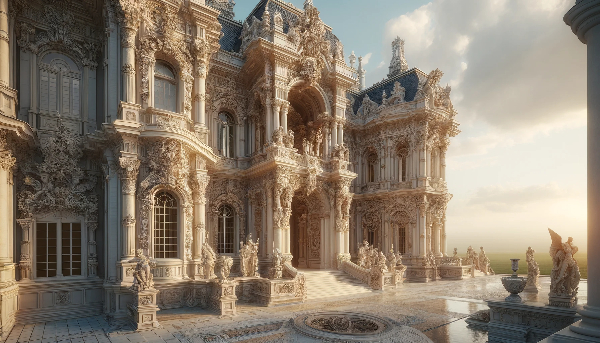Baroque architecture, born in the mid-sixteenth century and flourishing until the eighteenth century, is an artistic movement rich in contrasts, dynamic curves and extravagant ornamentation. Inspired by Baroque art and worn by iconic figures like Michelangelo, Francesco Borromini, and Pietro da Cortona, this architecture aims to impress and move. His influence can be found in many religious structures, palaces, and public spaces throughout Europe and the Spanish colonies in Latin America.
The Origins and Context of Baroque Architecture Baroque architecture emerged in a context of transformation and questioning within the Roman Catholic Church, particularly during the Counter-Reformation. This period was marked by an effort to strengthen the authority of the church and to attract the faithful through grandiose and moving buildings.
Characteristics of Baroque Architecture Baroque architecture is distinguished by elements such as dynamic curves, intricate shapes, and the generous use of light and shadow. Ceiling frescoes, often adorned with religious or mythological scenes, add a celestial dimension to interiors. Richly decorated facades, twisted columns, and imposing domes are also key elements of this style.
Emblematic Examples of Baroque Architecture in Italy In Italy, the Baroque gave birth to architectural masterpieces that continue to fascinate. The Church of St. Peter in Rome, with its dome designed by Michelangelo and its St. Peter's Square designed by Gian Lorenzo Bernini, is an emblematic example. The Barberini Palace, designed by Pietro da Cortona, is another jewel of the Italian Baroque, exemplifying the grandeur and extravagance of the style.
The Influence of Baroque Architecture in France In France, Baroque architecture was adopted and transformed during the reigns of Louis XIII, Louis XIV, and Louis XV. The Palace of Versailles, although often associated with classicism, incorporates many Baroque elements, especially in the ornate gardens and salons. The works of Frederick II of Prussia also show a Baroque influence, combined with other European styles.
The Expansion of the Baroque in Latin America The Spanish colonies in Latin America also embraced the Baroque style, creating a unique variant known as the "colonial Baroque." Notable examples include the churches of Quito in Ecuador and the Jesuit missions in Paraguay, built by the Society of Jesus.
Baroque Authors and Their Influence Baroque authors, such as those evoked in literature, often found mutual inspiration in the architecture of their time. Their literary works reflect the complexity and exuberance of Baroque structures, thus strengthening the connection between the different arts of the Baroque period.
The Church of Our Lady and Saint Michael in Baroque Architecture The Church of Notre Dame and the Church of Saint Michel are notable examples of Baroque architecture in France and Belgium. Their richly decorated facades and sumptuous interiors perfectly exemplify the ideals of the Baroque movement, creating spaces where spirituality and art meet.

Baroque and Rococo Architecture Baroque architecture evolved into the Rococo style in the early eighteenth century, marked by even more elaborate decoration and increased lightness. Although the two styles share common roots, Rococo stands out for its more graceful motifs and more intimate atmosphere, often seen in the interiors of noble houses.
Baroque Furniture and Its Influence The influence of Baroque architecture can also be found in the furniture of the time. Baroque furniture, such as chairs, chests of drawers, and armchairs, is often adorned with detailed carvings and gilding, reflecting the same sense of grandeur and opulence as architecture.
The Holy Square and the Public Spaces St. Peter's Square in Rome and other public spaces designed during the Baroque era are examples of how Baroque architecture transformed cities. These squares, often adorned with fountains and statues, create grandiose and imposing gathering places.
The Evolution of Baroque Architecture in the Nineteenth and Twentieth Centuries Although the heyday of the Baroque passed with the end of the eighteenth century, its influence lasted until the nineteenth and twentieth centuries. Architects and designers have continued to draw inspiration from Baroque forms and patterns, incorporating these elements into more contemporary structures.
Conclusion Baroque architecture, with its exuberant forms and sumptuous decorations, has left a lasting imprint on art and world culture. From majestic churches to opulent palaces and Baroque furniture, this style continues to fascinate and inspire, testifying to the importance of the Baroque movement in our architectural heritage.
FAQs
What are the main characteristics of Baroque architecture? Baroque architecture is distinguished by its curved shapes, extravagant ornaments, play of light and ceiling frescoes.
What are some famous examples of Baroque architecture in Italy? Notable examples include St. Peter's Church in Rome, Palazzo Barberini, and the works of Francesco Borromini and Michelangelo.
How did the Baroque influence architecture in France? In France, Baroque architecture was incorporated into famous structures like the Palace of Versailles and various churches during the reigns of Louis XIII, Louis XIV, and Louis XV.
What is the difference between Baroque and Rococo? Rococo is an evolution of the Baroque, characterized by lighter and graceful decorations, often seen in early eighteenth-century interiors.
How did the Baroque spread in Latin America? The Baroque spread to Latin America through the Spanish colonies, with notable examples in the churches of Quito and the Jesuit missions.
What are the distinctive elements of baroque furniture? Baroque furniture is often richly decorated with detailed carvings, gilding, and luxurious materials, reflecting the opulence of Baroque architecture.

